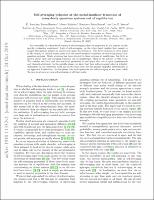Please use this identifier to cite or link to this item:
https://hdl.handle.net/20.500.12202/4842Full metadata record
| DC Field | Value | Language |
|---|---|---|
| dc.contributor.author | Torres-Herrera, E. Jonathan | - |
| dc.contributor.author | Schiulaz, Mauro | - |
| dc.contributor.author | Pérez-Bernal, Francisco | - |
| dc.contributor.author | Santos, Lea F. | - |
| dc.date.accessioned | 2020-01-07T20:01:25Z | - |
| dc.date.available | 2020-01-07T20:01:25Z | - |
| dc.date.issued | 2019-10 | - |
| dc.identifier.citation | Torres-Herrera, E. Jonathan ; Schiulaz, Mauro ; Pérez-Bernal, Francisco ; Santos, Lea F. (24 Oct 2019). Self-averaging behavior at the metal-insulator transition of many-body quantum systems out of equilibrium. arXiv:1910.11332v1 [cond-mat.stat-mech] | en_US |
| dc.identifier.uri | https://arxiv.org/abs/1910.11332 | en_US |
| dc.identifier.uri | https://hdl.handle.net/20.500.12202/4842 | - |
| dc.description | Scholarly article (pre-print) | en_US |
| dc.description.abstract | An observable of a disordered system is self-averaging when its properties do not depend on the specific realization considered. Lack of self-averaging, on the other hand, implies that sample to sample fluctuations persist no matter how large the system is. The latter scenario is often found in the vicinity of critical points, such as at the metal-insulator transition of interacting many-body quantum systems. Much attention has been devoted to these systems at equilibrium, but little is known about their self-averaging behavior out of equilibrium, which is the subject of this work. We consider two local and two non-local quantities in real space that are of great experimental and theoretical interest. In the metallic phase, we show that their self-averaging behavior is highly dependent on the observable itself and on the time scale, but the picture simplifies substantially as we approach localization. In this phase, the local quantities are self-averaging at any time, while the non-local ones are non-self-averaging at all time scales. | en_US |
| dc.description.sponsorship | ACKNOWLEDGMENTSE.J.T.-H. acknowledges funding from VIEP-BUAP(Grant Nos. MEBJ-EXC19-G, LUAGEXC19-G), Mex-ico. He is also grateful to LNS-BUAP for allowing use oftheir supercomputing facility. M.S. and L.F.S. are sup-ported by the NSF Grant No. DMR-1603418 and grate-fully acknowledges support from the Simons Center forGeometry and Physics, Stony Brook University at whichsome of the research for this paper was performed. F.P.B.thanks the Consejer ́ıa de Conocimiento, Investigaci ́on yUniversidad, Junta de Andaluc ́ıa and European RegionalDevelopment Fund (ERDF), ref. SOMM17/6105/UGR.Additional computer resources supporting this work wereprovided by the Universidad de Huelva CEAFMC HighPerformance Computer located in the Campus Univer-sitario el Carmen and funded by FEDER/MINECOproject UNHU-15CE-2848. Part of this work was per-formed at the Aspen Center for Physics, which is sup-ported by National Science Foundation grant PHY-1607611. | en_US |
| dc.language.iso | en_US | en_US |
| dc.relation.ispartofseries | cond-mat.stat-mech;arXiv:1910.11332v1 | - |
| dc.rights | Attribution-NonCommercial-NoDerivs 3.0 United States | * |
| dc.rights.uri | http://creativecommons.org/licenses/by-nc-nd/3.0/us/ | * |
| dc.subject | Self-averaging behavior | en_US |
| dc.subject | Statistical Mechanics | en_US |
| dc.subject | metal-insulator transition | en_US |
| dc.subject | many-body quantum systems | en_US |
| dc.subject | equilibrium | en_US |
| dc.title | Self-averaging behavior at the metal-insulator transition of many-body quantum systems out of equilibrium . | en_US |
| dc.type | Article | en_US |
| dc.contributor.orcid | 0000-0001-9400-2709 | |
| local.yu.facultypage | https://www.yu.edu/faculty/pages/santos-lea | |
| Appears in Collections: | Stern College for Women -- Faculty Publications | |
Files in This Item:
| File | Description | Size | Format | |
|---|---|---|---|---|
| Santos Self-averaging 1910.11332.pdf | arXiv | 2.89 MB | Adobe PDF |  View/Open |
This item is licensed under a Creative Commons License

